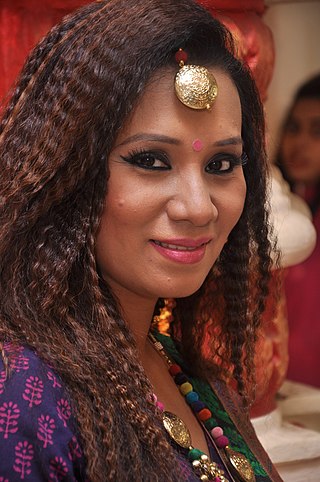
Bihar is a state in Eastern India. It is the third largest state by population, the 12th largest by area, and the 14th largest by GDP in 2021. Bihar borders Uttar Pradesh to its west, Nepal to the north, the northern part of West Bengal to the east, and Jharkhand to the south. Bihar is split by the river Ganges, which flows from west to east.
Shahabad district or Arrah district, headquartered at Arrah was a Bhojpuri speaking district in western Bihar, India, making the western border of Bihar with Uttar Pradesh. In 1972, the district was split into two districts: Bhojpur and Rohtas. Kaimur District was carved out from Rohtas in 1991 and Buxar District from Bhojpur in 1992.

Shailendra was a popular Indian Hindi-Urdu Poet, lyricist and film producer. Noted for his association with the filmmaker Raj Kapoor, singer Mukesh, and the composers Shankar–Jaikishan, he wrote lyrics for several successful Hindi film songs in the 1950s and the 1960s.
Chitragupt Shrivastava, better known as Chitragupt, was an Indian film music director in Hindi cinema and Bhojpuri cinema.
Media in Bihar started with Bihar Bandhu, the first Hindi newspaper published there.

The cinema of Bihar, a state in eastern India, primarily consists of films in the Bhojpuri language. Bihar also has smaller Maithili- and Magahi-language film industries. Cinema in the state began during the early 20th century.
Ganga Maiyya Tohe Piyari Chadhaibo is a Bhojpuri film released in 1963 directed by Kundan Kumar. It was the first-ever Bhojpuri film, and starred Kumkum, Ashim Kumar and Nazir Hussain. It had music by Chitragupta, lyrics by Shailendra and songs sung by Lata Mangeshkar and Mohammad Rafi. The film is based on author Acharya Shivpujan Sahay's short story Kahani Ka Plot.
The Bhojpuri Film Awards are an awards ceremony recognizing the best of Bhojpuri cinema. The awards have been presented annually since 2005.
Bihari culture refers to the culture of the Indian state of Bihar. Bihari culture includes Angika culture, Mithila culture, Bhojpuri Culture and the culture of Magadha.

Kumkum,, was an Indian actress.
Padma Khanna is an Indian actress, dancer and director. She appeared mainly in Hindi and Bhojpuri films in the 1970s and 1980s. She is most remembered for her role in the film Saudagar with Amitabh Bachchan and also as Queen Kaikeyi in Ramanand Sagar's epic series Ramayan (1987–88). She has appeared in two Telugu films with N. T. Rama Rao, in Desoddarakulu and Rajaputra Rahasyam. She also acted in Odia movie Sakshi Gopinath(1978)

Leela Mishra was an Indian actress. She worked as a character actor in over 200 Hindi films for five decades, and is best remembered for playing stock characters such as aunts. She is best known for her role of "mausi" in the blockbuster Sholay (1975), Dil Se Mile Dil (1978), Baton Baton Mein (1979), Rajesh Khanna films such as Palkon Ki Chhaon Mein, Aanchal, Mehbooba, Amar Prem and Rajshri Productions hits such as Geet Gaata Chal (1975), Nadiya Ke Paar (1982) and Abodh (1984). Her career's best performance was in Naani Maa in 1981, for which she received Best Actress award at the age of 73.

Nazir Hussain was an Indian actor, director and screenwriter. He was famous as a character actor in Hindi cinema and acted in almost 500 films. Dev Anand starred in a large proportion of the films he acted in.

Kalpana Patowary is an Indian playback and folk singer from Assam. She has recorded songs and folk music in several Indian languages, with Bhojpuri music being the major genre.
The 27th Annual Bengal Film Journalists' Association Awards were held in 1964, honoring the best in Indian cinema in 1963.
Sadhana Singh is an Indian actress who appears in Hindi films and television. Sadhana was born into a Rajput family in Varanasi, Uttar Pradesh. Her family hails from the Indian state of Punjab. Her first magazine shot was done by Pardeep Mishra. She started her film career with the 1982 film Nadiya Ke Paar, by writer-director Govind Moonis.
Bhojpuri music is a form of Hindustani Classical Music and includes a broad array of Bhojpuri language performances in distinct style, both traditional and modern. This form of music is mostly created in Indian states of Bihar, Uttar Pradesh and other countries like Nepal, Trinidad and Tobago, Suriname, Guyana, Netherlands, Mauritius and other Caribbean Islands.

Kunal Singh Yadav is an Indian actor associated with Bhojpuri cinema. Also referred to as Amitabh Bachchan of Bhojpuri Cinema because of his dominance on Bhojpuri cinema and also as Jitendra of Bhojpuri cinema because of his remarkable resemblance with the bollywood actor Jitendra, Kunal, in his four-decade long career, has acted in more than 250 movies. For his contributions to cinema, he was awarded the Rashtrakavi Dinkar Award in 2012 by Pranab Mukherjee.
Laagi Nahi Chhute Rama is a 1963 Bhojpuri film, directed by Kundan Kumar and produced by R. Tiwari. This was third Bhojpuri film after Ganga Maiyya Tohe Piyari Chadhaibo and Bidesiya. The film stars Sujit Kumar and Kumkum in the lead roles.








